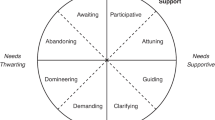Abstract
Measures of goal attractiveness, self-perceived energization, and self-perceived tension were taken immediately before 55 young male subjects were to perform an easy, difficult, or impossible motor activity in order to avoid an unpleasant noise. Results showed a greater magnitude of goal valence, and higher energization and tension in the difficult task condition than in the easy task condition. Subjects in the impossible task condition reported reduced energy relative to subjects in the difficult task conditions; however, tension and goal attractiveness scores did not differ significantly between these conditions. Theoretical implications are discussed.
Similar content being viewed by others
References
Ax, (1953). The physiological differentiation between fear and anger in humans.Psychosomatic Medicine, 51 433–442.
Brehm, J. W. (1979).Perceived difficulty and energization. Grant proposal, University of Kansas.
Brehm, J. W., Wright, R. A., Solomon, S., Silka, L., & Greenberg, J. (1983). Perceived difficulty of goal attainment, energization, and goal attractiveness.Journal of Experimental Social Psychology, 19 21–48.
Cantor, J. R., Bryant, J., & Zillmann, D. (1974). Enhancement of humor appreciation by transferred excitation.Journal of Personality and Social Psychology, 30 812–821.
Carmer, S. G., & Swanson, M. R. (1973). An evaluation of ten pairwise multiple comparison procedures by Monte Carlo methods.Journal of American Statistical Association, 68 66–74.
Contrada, R. J., Glass, D. C., Krakoff, L. R., Krantz, D. S., Kehoe, K., Isecke, W., Collins, C., & Elting, E. (1982). Effects of control over aversive stimulation and Type A behavior on cardiovascular and plasma catecholamine responses.Psychophysiology, 19 408–419.
Contrada, R. J., Wright, R. A., & Glass, D. C. (in press). Task difficulty, Type A behavior pattern, and cardiovascular response.Psychophysiology.
Elliott, R. (1969). Tonic heart rate: Experiments on the effects of collative variables lead to a hypothesis about its motivational significance.Journal of Personality and Social Psychology, 12 211–228.
Kukla, A. (1972). Foundations of an attributional theory of performance.Psychological Review, 79 454–470.
Lazarus, R. S. (1968). Emotions and adaptation: Conceptual and empirical relations. In D. Levine (Ed.),Nebraska symposium on motivation (pp. 25–122). Lincoln: University of Nebraska Press.
Light, K. C., & Obrist, P. A. (1980). Cardiovascular response to stress: Effects of opportunity to avoid shock, shock experience, and performance feedback.Psychophysiology, 17 243–252.
Light, K. C., & Obrist, P. A. (1983). Task difficulty, heart rate reactivity, and cardiovascular responses to an appetitive reaction time task.Psychophysiology, 20 301–312.
Manuck, S. B., Harvey, A. E., Lechleiter, S. L., & Neal, K. S. (1978). Effects of active coping on blood pressure responses to threat of aversive stimulation.Psychophysiology, 15 544–549.
Obrist, P. A., Gaebelein, C. J., Teller, E. S., Langer, A. W., Grignolo, A., Light, K. C., & McCubbin, J. A. (1978). The relationship among heart rate, carotid dP/dt, and blood pressure in humans as a function of the type of stress.Psychophysiology, 15 102–115.
Plutchik, R., & Ax, A. F. (1967). A critique ofDeterminants of emotion state by Schachter and Singer (1962).Psychophysiology, 4 79–82.
Reisenzein, R. (1983). The Schachter theory of emotion: Two decades later.Psychological Bulletin, 94 239–264.
Schacter, S., & Singer, J. (1962). Cognitive, social and psychological determinants of emotional state.Psychological Review, 69 379–399.
Schwartz, G. E., Weinberger, D. A., & Singer, J. (1981). Cardiovascular differentiation of happiness, sadness, anger and fear following imagery and exercise.Psychosomatic Medicine, 43 343–363.
Solomon, S., Holmes, D. S., & McCaul, K. D. (1980). Behavioral control over aversive events: Does control that requires effort reduce anxiety and physiological arousal?Journal of Personality and Social Psychology, 39 729–736.
Thayer, R. E. (1967). Measurement of activation through self-report.Psychological Reports, 20 663–678.
Thayer, R. E. (1978a). Factor analytic and reliability studies on the Activation-Deactivation Adjective Check-List.Psychological Reports, 42 747–756.
Thayer, R. E. (1978b). Toward a psychological theory of multidimensional activation (arousal).Motivation and Emotion, 2 1–34.
Toi, M. (1980).The effect of perceived difficulty of a cognitive task on goal attractiveness. Unpublished master's thesis, University of Kansas, 1980.
Winer, B. J. (1971).Statistical principles in experimental design (2nd ed.). New York: McGraw-Hill.
Wright, R. A. (1982). Perceived motivational arousal as a mediator of the magnitude of goal valence.Motivation and Emotion, 6 161–180.
Wright, R. A. (1984). Motivation, anxiety and the difficulty of avoidant control.Journal of Personality and Social Psychology, 46 1376–1388.
Wright, R. A., Toi, M., & Brehm, J. W. (1984).External difficulty and interpersonal attractiveness. Manuscript submitted for publication.
Author information
Authors and Affiliations
Additional information
We would like to thank Richard J. Contrada for his very helpful comments on an earlier draft of this article. This research was supported by the Small Grants Subcommittee of the University of Kansas, a Biomedical Sciences Support Grant, and Training Grant MH 151138-5 from the National Institutes of Health. Preparation of the manuscript was supported in part by research fellowship funds awarded to the first author by the National Institute of Mental Health (NIH).
Rights and permissions
About this article
Cite this article
Wright, R.A., Brehm, J.W. The impact of task difficulty upon perceptions of arousal and goal attractiveness in an avoidance paradigm. Motiv Emot 8, 171–181 (1984). https://doi.org/10.1007/BF00993072
Issue Date:
DOI: https://doi.org/10.1007/BF00993072




